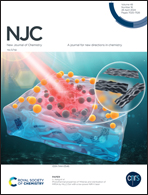Nanopolyhedral Zn/Fe-NC derived from bimetallic zeolitic imidazole frameworks as an efficient catalyst for the oxygen reduction reaction in an air-cathode microbial fuel cell†
Abstract
The development of carbon-based catalysts to substitute Pt-based catalysts for the oxygen reduction reaction is highly important for promoting their practical application in energy conversion. Herein, we prepare Zn, Fe and N-codoped porous carbon (Zn/Fe-NC-x) as a cathode catalyst via a facile one-step pyrolysis predesigned bimetallic zeolitic imidazole framework. Systematic electrochemical studies demonstrated that the synthesized Zn/Fe-NC-0.5 exhibits higher electrocatalytic activity towards the oxygen reduction reaction. In particular, Zn/Fe-NC-0.5 has a smaller charge transfer resistance, larger exchange current density, and much higher open circuit potential and mainly proceeds via an efficient four-electron pathway. A microbial fuel cell equipped with the synthesized catalyst exhibited the highest maximum power density of 1954 ± 20 mW m−2. In addition, the effects of the iron doping content on the oxygen reduction reaction performance and maximum power density were evaluated: a moderate Fe doping content plays a crucial role in improving the catalytic activity, and the synergistic effect of Zn, Fe and N codoping promotes cathodic performance. In brief, Zn/Fe-NC, which has the advantages of facile synthesis, environmental friendliness and excellent electrochemical activity, is a promising Pt-alternative catalyst for the oxygen reduction reaction in air-cathode microbial fuel cells.



 Please wait while we load your content...
Please wait while we load your content...